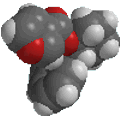 |
Chapter 8: Nucleophilic Substitution |
 |
Solvent Effects
In general terms, the choice of solvent can have a significant
effect on the performance of a reaction.
Factors when chosing a solvent are:
- solubility : need to get reagents in the same phase,
the molecules need to collide to react !
- usually, the solvent needs to unreactive towards the
reagents
(except in reactions where the solvent is the Nu : "solvolysis")
- how will the solvent affect the rate of reaction ?
For an SN1 reaction, the polarity and ability of
the solvent to stabilise the intermediate carbocation is of paramount importance,
as shown by the relative rate data for the solvolysis of tBuCl.
| Solvent |
Dipole moment, μ |
Dielectric constant, ε |
Relative Rate |
| CH3CO2H |
1.68 |
6 |
1 |
| CH3OH |
2.87 |
33 |
4 |
| H2O |
1.84 |
78 |
150,000 |
| Dipole moment, µ
in debye |
For an SN2 reaction, the effect of solvent polarity
is usually much less, but the ability (or really lack there of) of the solvent
to solvate the nucleophile is the important criteria, as shown by the relative
rate data for the SN2 reaction of nBuBr with N3-.
| Solvent |
Dipole moment, μ |
Dielectric constant, ε |
Relative Rate |
Type |
| CH3OH |
2.87 |
33 |
1 |
protic |
| H2O |
1.84 |
78 |
7 |
protic |
| DMSO |
3.96 |
49 |
1,300 |
aprotic |
| DMF |
3.82 |
37 |
2,800 |
aprotic |
| CH3CN |
3.92 |
38 |
5,000 |
aprotic |
|
|
|
|
|
POLAR PROTIC SOLVENTS (polar and ability to be
H-bond donor)
- have dipoles due to polar bonds
- can H atoms that can be donated into a H-bond
- examples are the more common solvents like H2O
and ROH
- remember basicity is also usually measured in water
- anions will be solvated due to H-bonding, inhibiting
their ability to function as Nu
POLAR APROTIC SOLVENTS (polar
but no ability to be H-bond donor)
- have dipoles due to polar bonds
- don't have H atoms that can be donated
into a H-bond
- examples are acetone, acetonitrile, DMSO, DMF
- anions are not solvated and are
"naked" and reaction is not inhibited
|
 |
Overall
- All nucleophiles will be more reactive in aprotic
than protic solvents
- Those species that were most strongly solvated in polar
protic solvents will "gain" the most reactivity in polar aprotic
(e.g. F-).
- Polar aprotic solvents are typically only used
when a polar protic solvent gives poor results due to having
a weak Nu, (esp. F-, -CN, RCO2-)
